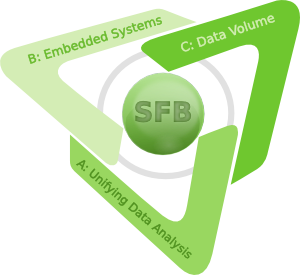


One major strength of the research center is the strong cooperation between all projects. Overlapping problems are targeted jointly and three research groups bridge gaps between the project's topics and provides the place for comprehensive work.
The research group Information Retrieval concentrates on modelling and preserving confidentiality of information. What motivates the data analysis? Which kind of information needs to be extracted and how do the pieces of information need to be presented for a solid decision-making base? How can the information be concealed, that only mandatory pieces are revealed and privacy of persons is respected? Answers to these questions need to incorporate a-priori knowledge of decision makers, type of decisions (e.g. classification, clustering, regression), field of application (medical, physics, electrical engineering etc.) and theoretical fundamentals (Computational complexity theory, statistics, data mining, machine learning).
The research group Resource Constraints sets its focus on embedded systems. Topics covered range from automated design of embedded systems, operating systems up to specific technical realizations. The concepts for realizations include general aspects as well as applications specific aspects targeting astro physics, biomedical analysis, network communication, production and physics of transports. The work in this research groups needs to extract the demands of each scenario and identify constraints implied by limited resources. How is the data collected, which types of sensors are available? How and in which encoding is the data transmitted? How much energy is available? Answering these questions leads to transparent evaluation of constraints and enables control of resource consumption.
Finally, the research group Data Analysis collects all analysis algorithms, tries to generalize specific results and evaluates the algorithms for their impacts on resource consumption. For each algorithm the suitable data representation needs to be defined and possibly transformed. How can features be selected, extracted or generated for a stable, reliable prediction and the selection process automated? How do bias and variance change for different classes of algorithms? Which new concepts beside clustering, classification and regression can be developed? Can real-time criteria for time sequence analysis been met, even for limited resources? These aspects will be covered theoretically as well as practically, with implementations in popular data analysis software like R or Rapidminer.
More information about all projects can be found at the Project Overview.